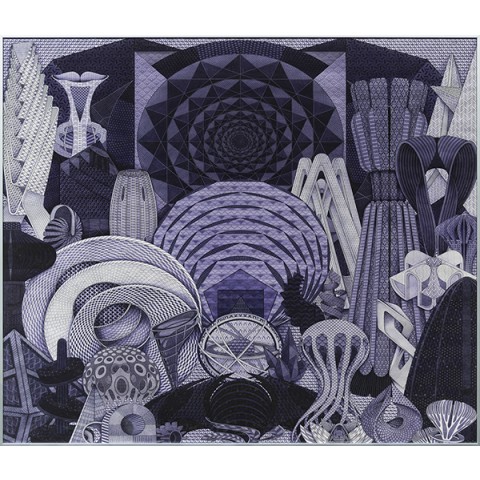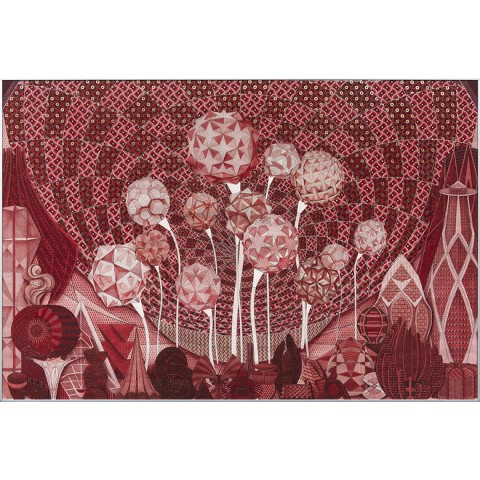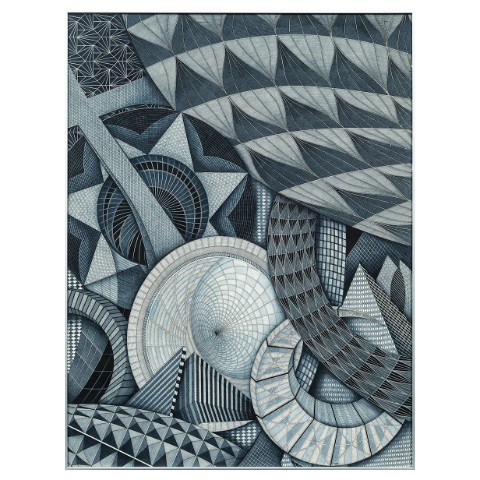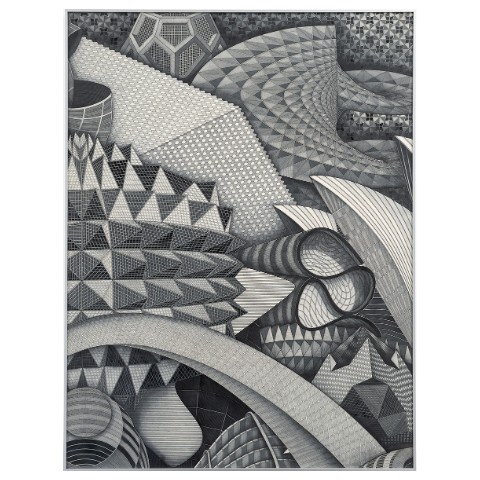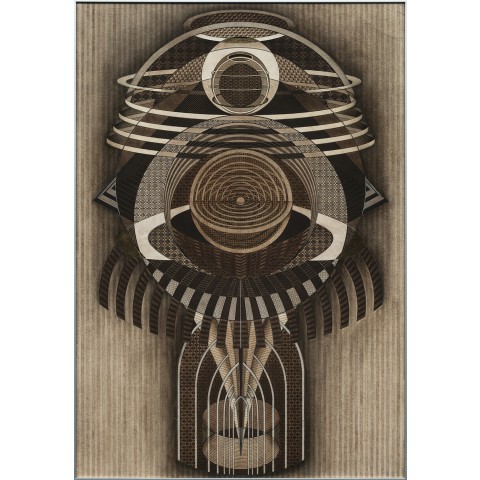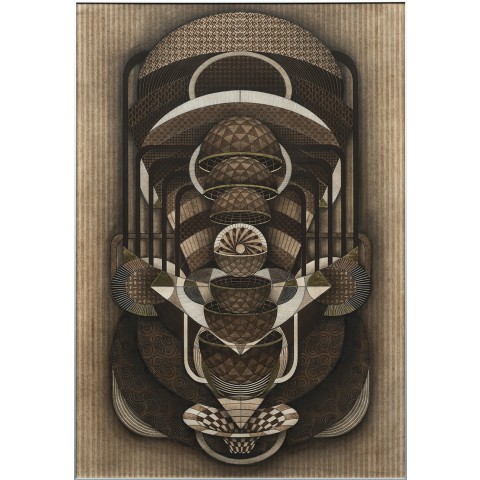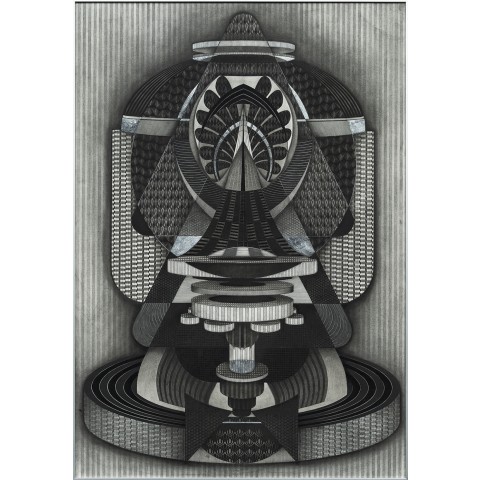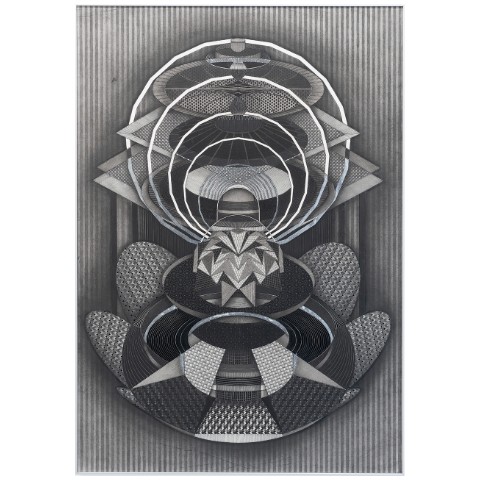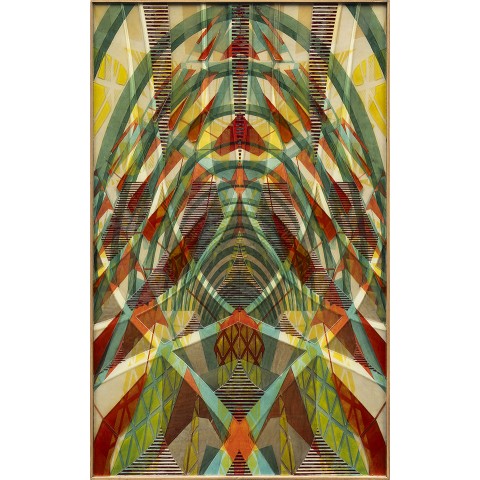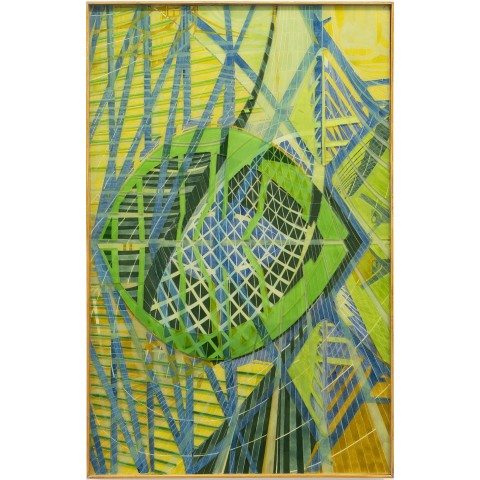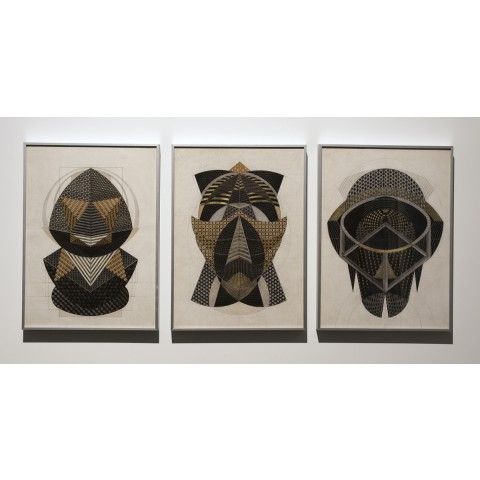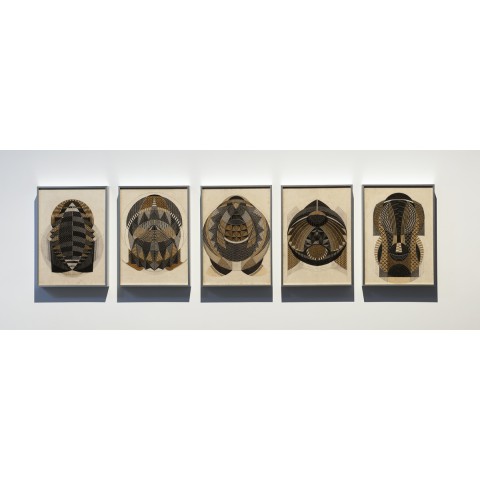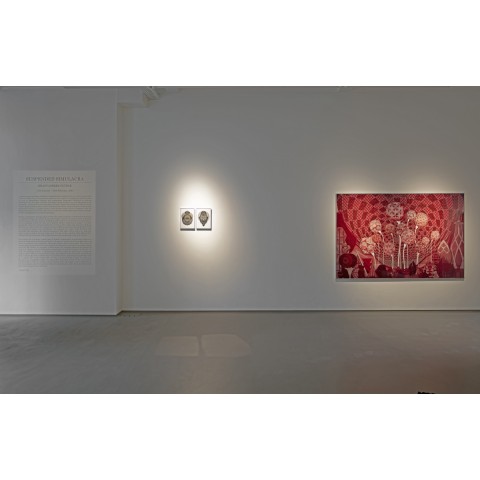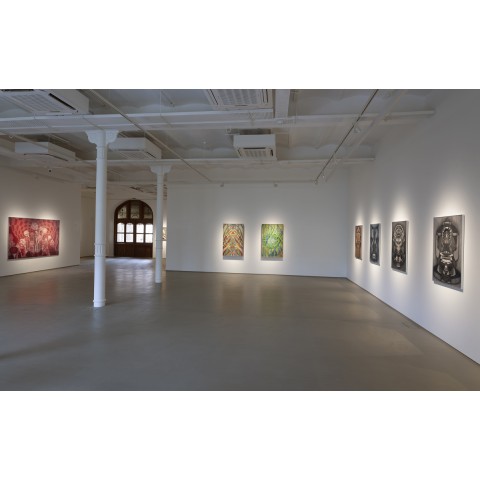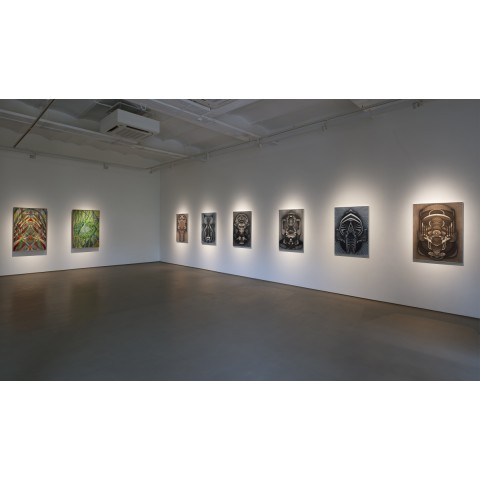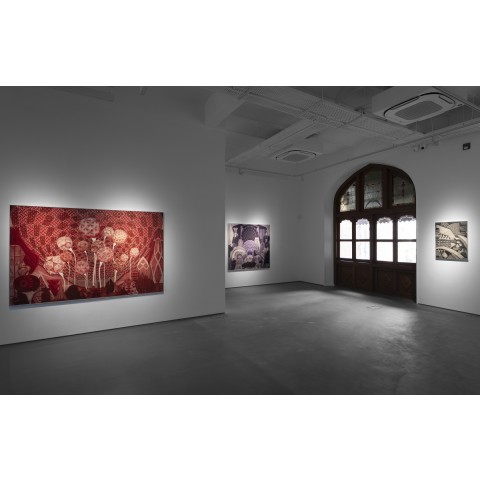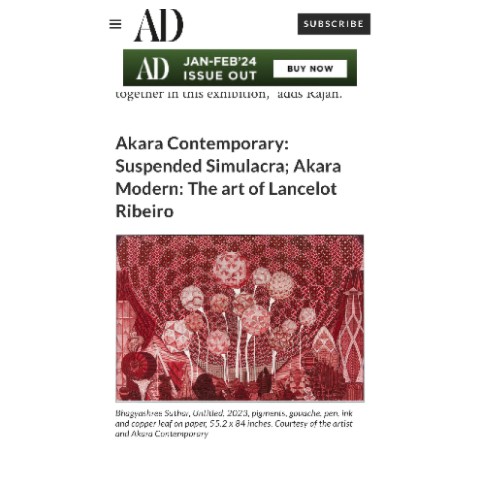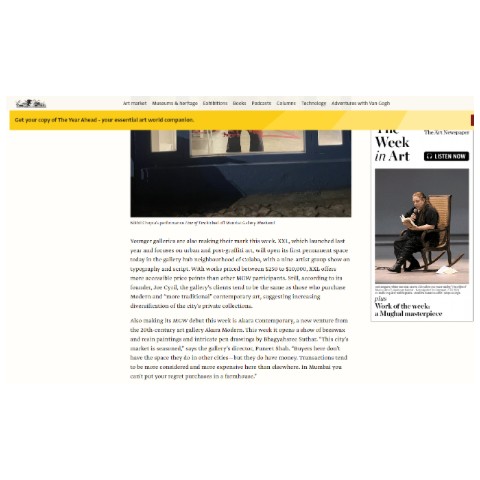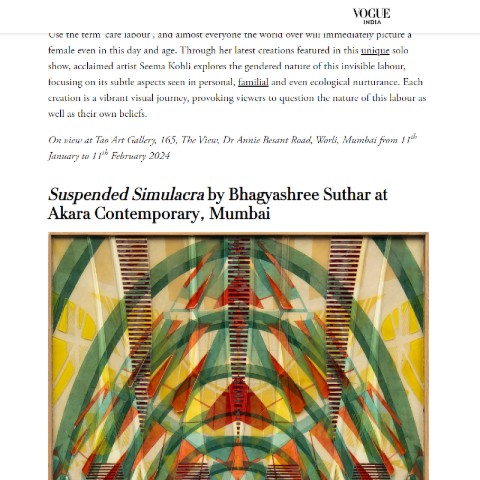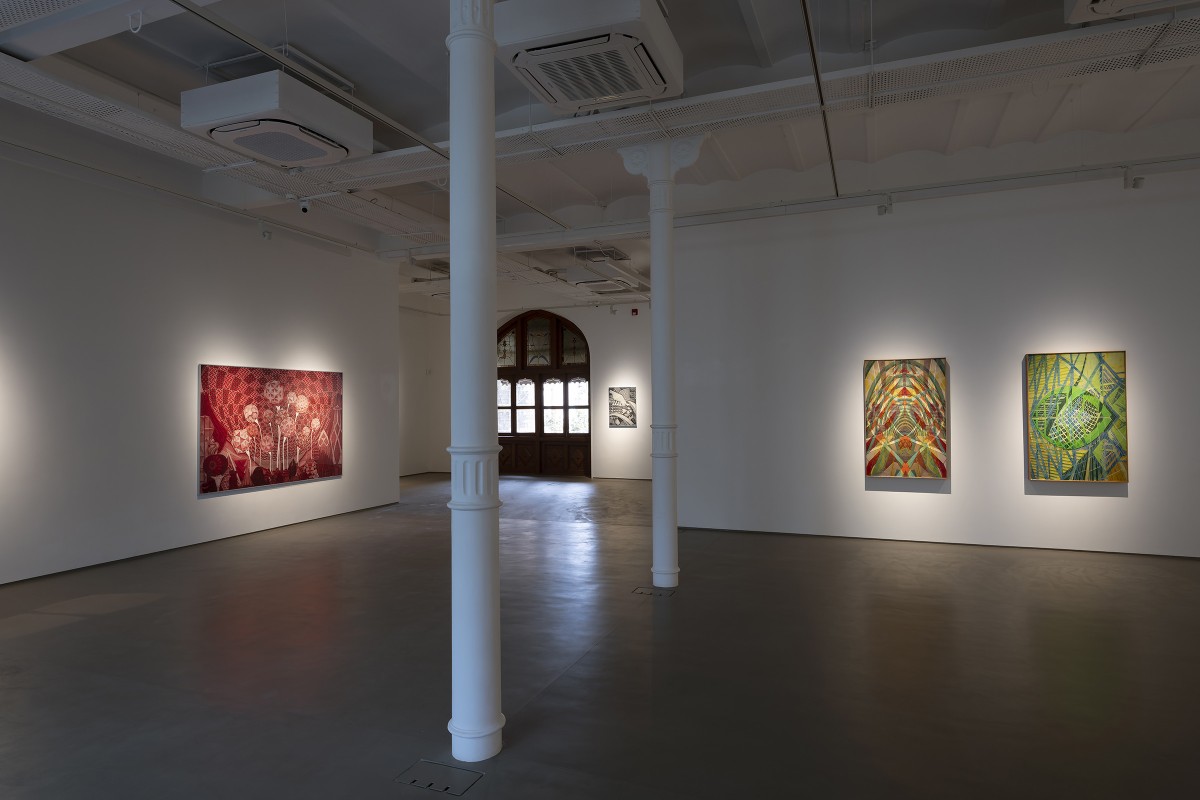
SUSPENDED SIMULACRA: BHAGYASHREE SUTHAR
January 11 - February 24 , 2024
A series of spherical domes ambulate a nephroid globe, elsewhere the eye is invited to trail the ascent of a helical cone. Constructed as intricate alter-worlds, it is tempting to read the works on view at Bhagyashree Suthar’s upcoming solo presentation Suspended Simulacra as abstract landscapes. Yet the surface assembly of recursive forms, belying an eye towards precision and symmetry, is punctured by the appearance of depth—shapes are spliced to reveal their inner worlds, planar incisions infuse an optic kineticism that refuses the petrification of represented landscapes. Evoking a complex liveness that balances eternal forms of geometry with the ephemeral textures of the built, this suite of works are orbital explorations of time and sight, or their entanglements as temporal perception.
Suthar contemplates varying scales of time—the utopic futurism of modernist architecture exemplified through the metrics of mass and volume, and the retrotopic survey of personal memory that is occluded, visceral. Architectural forms have often looked to the organic world for illumination on order, symmetry, craft. Even when asserting a negation of the natural world, built structures are draped in deep time as life and its elements wilfully erupt—the earth and sky propel entropy, people cast their memories on stone and cement. Suthar betrays a knowledge of this—that formal divisions are matters of appearance, and these must be prodded, whether through synthesis or discordance of forms, to arrive at a revelation.
The evanescent and the monumental overlap in Suthar’s consciousness, which is interested in the pursuit of an essential knowability, that which is imperceptible but must be evoked. In the paintings, there is an intent to dissolve the surface and to attend to the strata below. Having laboured at this complexity, Suthar seeks to reproduce its emanation. What emerges from this intuitive process are dense fractals, often monochromatic and multimodal. The works follow a structure that is usually totemic or polar, evoking the sense of witnessing a celestial occurrence such as the Pillars of Creation. The famed image depicting towers of interstellar clouds is a vital reference—the creation of new stars is accompanied by the erosion caused by the light of nearby stars; life and degeneration conjoin. At other times, the works conjure formations of the kaleidoscope, an infinitely multiplied sequence. The solidity of iconography is appended with an open network of references as vast as the impossible objects drawn by MC Escher, the buildings of Zaha Hadid, the imagined libraries and gardens of Jorge Luis Borges, and the Warburgian pathosformel or “psychic batteries” of emotion.
Turning to public archives of architecture on social media, and to persisting motifs from her own childhood, Suthar undertakes a project of striking magnitude—how to see through and beyond the linear order of time that separates childhood from future, or that severs the transient moment of light passing through a wall of glass from the qualities of contact and translucency that compose the visible world. The pursuit for an eternal, porous time in Suthar’s compositions is revelatory—there is a desire to retain universal structures found in the natural world such as the golden ratio, and there is a regard for the amorphous, intangible flickers such as the flush of stray petals.
This methodology invites consideration on the intersection of pigment, mixed media and light towards the appearance of chromatic effects. Working with materials that extenuate the viewer’s engagement with light, Suthar layers her paintings with beeswax, metallic foil and resin, such that the surface inhabits light differentially, shifting with the movement of the viewer’s gaze and the progression of hours in the day. There is a study of phosphorescence—of how to summon an inner illumination through the exploration of gradients along a colour and the careful, studied layering of materials, most prominent in a striking gouache painting on plywood, layered with beeswax and resin. The layering of materials in a spectrum of warm, verdant tones, invites a sublime ascent of the viewer’s gaze, following a trail of refracted light, a spectacular moment frozen in time. Opacity emerges and recedes, as shards of resin punctuate the progression towards a crescendo. The result is a moment of visual rapture that defies description. Even in works situated further along the spectrum, the dark, cinderous hues appear to emit the shadow of a gleam.
As such, the paintings perform a diagrammatic function—these are models for a synchronic utopia, a future which can be grasped by aging, time-mottled hands. Structured as models, the paintings forge a relationship with a referent that is necessarily absent, immaterial; the works stand in to conjure this world of fluid time, to bring it to the purview of sight as simulation, blueprint, or cartographic schema. In this, they share a remarkable visual affinity with the illustrations of early modern manuscripts on geology and technology that sought to grasp fundamentals or the primary mechanics of all phenomena.
In one of the rare works in hues of red and glistening copper leaf, that follows a horizontal scheme brimming with geometric formations, eager stalks erupt from a ground overripe with varied botanical forms and interspersed with a trefoil knot and other topological objects. At the head of each tendrilous stalk is a sphere composed of other shapes—a cellular amalgamation lending each sphere a distinct visual contour. Behind these spheres is a vortex of waves, suggesting a gravitational centre that is concealed by a stalk. Referencing that which is perceptually absent, the work strikingly resembles the illustration depicting the seventeenth-century polymath Athanasius Kircher’s atlases of the earth’s core in Mundus Subterraneous, published in 1665. In this painting, there is an uncanny recall of Kircher’s diagrams depicting the interconnectedness of fire and water inside the earth, said to mirror the nerves of the body, and drawn as such. The trembling capillaries connecting orbs of fire in those illustrations are precursors to the stalks that one sees in the painting, the spheres no less than the very foundations that keep the world in place. In both illustration and painting, the background is a cascade of bulbous forms, suggesting dynamism and life.
Kircher’s studies to decipher the earth were steeped in imaginative and philosophical flourishes to cohere principles that could narrate, if not explain, the observed world. Kircher’s attempt to depict a system not perceived but rather cognised is not unlike Suthar’s enquiry into the immanence of matter or simultaneity of time. The representation of these philosophical aspects demand the construction of a visual system—a syntax that must be upheld in each work. The topological frame, where shapes contract, distend and disassemble provides this syntax. Even as forms abound in these works, each is unique, often interlinked with others in a rotational arc.
The imagined cartographies in Suthar’s works chart a terrain that is imbued with life. They invite the viewer to partake in the subtle movements underway in the paintings and to resist the stilling of the eye. Eschewing any form of anamorphosis, the works allow viewers to dwell in the intricate detail that is evident and crucially to partake the image and the scheme as a whole, such that they may unravel the mechanics that propels each painting into a perpetual motion to nestle within themselves.
In Suspended Simulacra, Suthar invites a protracted consideration on what is entailed in perceiving the world, not simply as given phenomenon, but what sustains past the immediacy of the ever-renewing now, and what is emergent across dimensions of space, time and being.
- Arushi Vats
